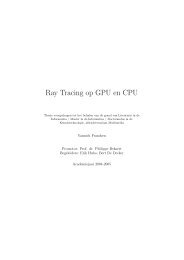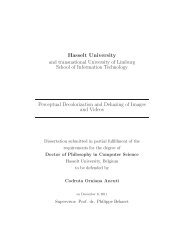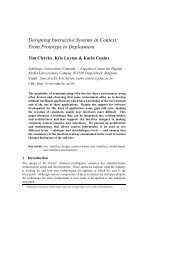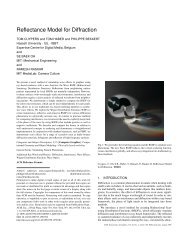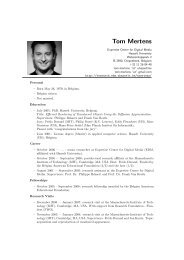DOCTORAATSPROEFSCHRIFT - EDM - UHasselt
DOCTORAATSPROEFSCHRIFT - EDM - UHasselt
DOCTORAATSPROEFSCHRIFT - EDM - UHasselt
You also want an ePaper? Increase the reach of your titles
YUMPU automatically turns print PDFs into web optimized ePapers that Google loves.
6 Contributions<br />
all virtual interactions in the VE. Also, the system allows for instant<br />
integration of new, ‘unknown’ interactive objects during simulation;<br />
• the ExtReAM library, a plug-in-based animation library. This library<br />
will enable us to improve realism by enabling physical simulation and<br />
more dynamic animations for objects and user embodiments which can<br />
result in better VE experiences and higher levels of presence if used properly.<br />
ExtReAM is built around an object-oriented, platform-independent<br />
core that can easily be extended with plug-ins. While the core system<br />
provides functionality for managing plug-ins and objects, the plug-ins<br />
are responsible for more specific tasks such as object loading and various<br />
animation techniques. Different plug-ins can be used for different<br />
platforms, when necessary, and plug-ins need to be loaded only when<br />
their functionality is required. In this way, ExtReAM is prepared for<br />
next generation VEs on different platforms;<br />
• the physical interactive object approach, an extension of the basic interactive<br />
object approach, that increases the realism of the interactive world<br />
by employing rigid body simulation to calculate all actor and object<br />
movements. Furthermore, it allows objects to contain physical actions<br />
and properties as well. The extended animation and simulation functionalities<br />
are provided by integrating the ExtReAM library. By combining<br />
realistic simulation with our dynamic interaction mechanism, much more<br />
lively virtual worlds can be achieved with minimal effort;<br />
• new techniques for interacting with virtual environments. We show how<br />
inverse kinematics can be used to increase the interaction possibilities<br />
through realistic direct avatar control. This allows for easy, on-the-fly<br />
creation of new interactions. Furthermore, we present a way to couple<br />
stable haptic force feedback to rigid body simulation in order to achieve<br />
haptic travel in dynamic VEs. Through the use of a haptic IO device,<br />
we provide the user with a realistic way to control an animated avatar’s<br />
travel in a VE. Furthermore, we show how several physically simulated<br />
forces based on changes in the terrain and avatar collisions, influence<br />
travel and give the user feedback on what is happening to its virtual<br />
representation; increasing his feeling of presence;<br />
• formal and informal evaluations of all of the proposed solutions and techniques<br />
through experimentation, integration in real-world applications or<br />
usability testing.



